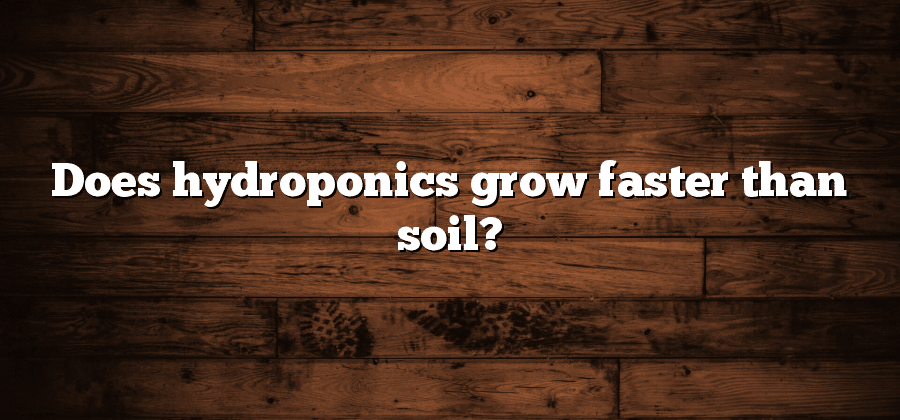Advantages of Hydroponics over Soil-based Cultivation
Hydroponics, a soil-less cultivation method, offers several advantages over traditional soil-based cultivation practices. One key advantage is improved water efficiency. In hydroponics, water is utilized more efficiently as it is recirculated and reused within the system. This reduces water wastage and ensures that plants receive the exact amount of water they need, without any excess draining away. Furthermore, the controlled environment of hydroponics allows for optimal nutrient uptake by plants, as nutrients are delivered directly to the root system. This results in faster and healthier growth, as plants can access essential nutrients without competing with weeds or other plants for resources.
Another advantage of hydroponics is the ability to grow crops in limited space. Traditional soil-based cultivation typically requires large amounts of land, which is not always readily available, especially in urban areas. Hydroponic systems, on the other hand, can be set up in smaller areas, such as greenhouses or vertical farming structures, making it possible to grow crops in urban environments where land is limited. Additionally, hydroponics offers higher yield potential compared to soil-based methods. With precise control over environmental factors like light, temperature, and nutrient levels, plants can achieve optimal growth conditions, resulting in increased crop productivity. This can be particularly beneficial in areas with unfavorable growing conditions or where there is a high demand for fresh produce. Overall, hydroponics provides a promising alternative to traditional cultivation methods, offering greater efficiency and versatility in crop production.
Key Factors Affecting Growth Speed in Hydroponics
The growth speed in hydroponics is influenced by several key factors that need to be carefully managed in order to optimize plant growth and productivity. One important factor is the selection and balance of nutrients provided to the plants. In a hydroponic system, nutrients are delivered directly to the roots, allowing for precise control over their availability. This enables plants to receive all the essential elements they need for growth, without the limitations often present in soil-based cultivation. By ensuring the right balance of nutrients, hydroponic growers can promote faster growth rates and healthier plants.
Another crucial factor affecting growth speed in hydroponics is the quality and intensity of light. Light plays a critical role in photosynthesis, the process by which plants convert light energy into chemical energy to fuel their growth. In a hydroponic system, artificial light sources can be tailored to provide the optimal spectrum and intensity for different stages of plant growth. By providing the right kind of light for the plants, growers can promote faster photosynthesis and ultimately accelerate growth rates. Additionally, the duration of light exposure must be carefully controlled to mimic natural light cycles and ensure proper growth patterns.
Comparing Nutrient Availability in Hydroponics and Soil
When comparing nutrient availability in hydroponics and soil-based cultivation, it becomes apparent that hydroponics offers several advantages in this regard. Unlike traditional soil-based methods, where nutrients are absorbed by plants through soil, hydroponics involves the direct delivery of nutrients to the plant roots in a water-based solution. This ensures that the plants have easy access to the necessary nutrients, resulting in faster and more efficient growth. Moreover, in hydroponics systems, the nutrient solutions can be carefully controlled, allowing for precise adjustments and optimization of the nutrient levels according to the specific needs of each plant.
In soil-based cultivation, on the other hand, nutrient availability can vary significantly depending on the quality of the soil. Certain types of soil may be lacking in essential nutrients, requiring additional fertilization to ensure adequate plant growth. In addition, the presence of certain minerals or pH imbalances in the soil can affect the availability of nutrients to plants. This can result in slower growth and reduced crop yields. With hydroponics, these issues are bypassed as the nutrients are directly supplied to the plants, ensuring optimal and consistent nutrient availability.
Understanding the Impact of Light on Growth Rates in Hydroponics
Light is a critical factor in hydroponic cultivation, as it directly influences the growth rates of plants. In a hydroponic system, growers have the advantage of being able to carefully control the amount and quality of light that their crops receive. Unlike in soil-based cultivation where plants rely on natural sunlight, hydroponic systems use artificial lighting sources to provide the necessary light energy for growth.
The impact of light on growth rates in hydroponics can be observed in several ways. Firstly, light affects the photosynthetic process, where plants convert light energy into chemical energy to support their growth. The intensity of light directly influences the rate of photosynthesis, with higher light levels typically resulting in increased growth rates. Additionally, the wavelength of light is crucial as different colors or spectra have varying effects on plant growth and development. For instance, blue light is associated with promoting vegetative growth, while red light is more conducive to flowering and fruiting stages. By understanding and manipulating these factors, hydroponic growers can optimize light conditions to accelerate growth rates and improve crop yields.
Exploring the Role of Temperature in Hydroponic Crop Growth
Temperature is a crucial factor in the growth of hydroponic crops. Just like in traditional soil-based cultivation, the right temperature plays a significant role in optimizing plant growth and overall crop health. The impact of temperature can be felt at various stages, from seed germination to flowering and fruiting.
Maintaining the ideal temperature range is vital to ensure optimal growth rates in hydroponics. Generally, most hydroponic crops thrive in temperatures between 65°F to 80°F (18°C to 27°C). However, different crops have specific temperature requirements, so it is essential to adjust the temperature accordingly. Higher temperatures can accelerate the growth process, but if the temperature goes beyond the optimal range, it can lead to issues like reduced nutrient absorption, increased susceptibility to diseases, and stunted growth. Conversely, lower temperatures can slow down growth and impede nutrient uptake. Therefore, closely monitoring and controlling the temperature in hydroponic systems is paramount to achieving optimal crop growth and maximizing yields.






